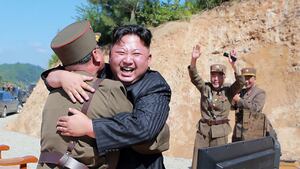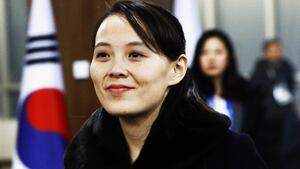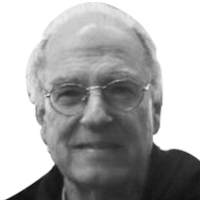SEOUL—Ten years after the death of North Korea’s long-ruling father, Kim Jong Il, his youngest son Kim Jong Un has ruthlessly tightened one-man rule but failed miserably to meet the basic needs of the vast majority of his poverty-stricken country’s 25.6 million people.
The kid was just 27, with virtually no prior experience, when his father died suddenly at 70 on Dec. 17, 2011. To the shock of skeptics who doubted he was up to the job and were sure he would soon fall from grace and power, he swept aside his relatives and his father’s aides in asserting control over the ruling Workers’ Party and the enormous armed forces.
Now 37, maturing into middle age, Kim Jong Un can look back on a decade in which he’s ordered the executions of hundreds of rivals, bureaucrats, and military officers perceived as threatening his unobstructed grip on a dynasty harking back to his grandfather, Kim Il Sung, installed by the Soviet Union in 1945. On the way he’s also ordered four nuclear tests and dozens of missile flights showing North Korea as a threat both to its nearest neighbors, South Korea and Japan, and to targets in the U.S.
But how long can Kim brandish such fearsome weaponry while his health deteriorates in tandem, it seems, with the economy?
“He was good for the first four or five years,” said Choi Jin-wook, president of the Center for Strategic and Cultural Studies in Seoul. “Now he’s trying to get out of economic hardships.” To do that, Choi told The Daily Beast, “He’s trying to please his people,” but “he can’t because of economic difficulties.” Since COVID-19 led Kim early last year to shut down the Yalu and Tumen river borders with China, trade “is 10 percent of previous years,” said. Choi. “Oil and food are almost nothing. He has failed in every sense.”
To guarantee power, however, Kim has wiped out anyone who would question—much less challenge—his authority beginning with two of his father’s highest-level aides.
The chief of staff of the armed forces, Ri Yong Ho, was ousted and reportedly executed in July 2012. In December 2013, Kim’s uncle-in-law, Jang Song Thaek, who was married to Kim Jong Il’s sister, was dragged out of a politburo meeting and beaten before his execution on a wide range of charges, mostly to do with corruption. Both Ri and Jang had walked with Kim Jong Un for three hours on a snowy day in December 2011 beside the hearse bearing Kim Jong Il’s casket and were assumed to be tutoring the young man on the ways of statecraft.

Kim Jong Un salutes as he and his uncle Jang Song-thaek (3rd L) accompany the hearse carrying the coffin of Kim Jong Il during his funeral procession in Pyongyang on Dec. 28, 2011.
Kyodo/ReutersThen, most dramatically, Kim’s older half-brother, Kim Jong Nam, was murdered in February 2017 in Kuala Lumpur Airport by two young women paid small sums by North Korean agents to smear what they were told was water on his face as a prank. The water turned out to be VX nerve gas.
These three deaths portended the killing of scores of others who might have been close to them. At Kim’s behest, the regime has also sought to annihilate what he has called “the vicious cancer” of popular South Korean culture as exemplified in K-Pop and Squid Game, snuck into the country at grave risk.
The Seoul-based Transitional Justice Working Group said this week that many of those caught “watching or distributing South Korean video” had been executed. On the basis of interviews with 683 escapees from North Korea, the report lists 27 official burial sites and details 23 executions. “Interviews reported that inhumane treatment of the accused before execution—used as a warning to the public—has persisted under Kim Jong Un” even though “in some cases pardons were issued” to show his “benevolence.”
Executions, often in public, had been routine throughout the reigns of both Kim Il Sung, who died in 1994, and then Kim Jong Il, but “after Kim Jong Un took power it became worse,” according to Ji Seung-ho, who escaped from North Korea in 2006. Ji, now a member of South Korea’s National Assembly, told members of the Seoul Foreign Correspondents Club that the new leader, not yet 30, “started to target the upper class of officials.” The reason, said Ji, was “to showcase his power.”

A North Korean soldier stands before spectators during a mass military parade at Kim Il Sung square in Pyongyang on Oct. 10, 2015.
Ed Jones/AFP via GettySimultaneously, fearful of unbridled military influence, Kim sought to elevate the party above the armed forces, about 1.2 million troops on active duty, including tens of thousands within a few miles of the demilitarized zone between North and South Korea.
Until Kim Jong Un took charge, “it was military first,” said Ji. “He has transitioned to placing more power in the party,” making himself general secretary of the party as well as president of the state affairs commission.
Robert Collins, author of books and studies on power struggles in North Korea, ranks control of the party’s Organization and Guidance Department as Kim’s “biggest achievement.” Under Kim’s younger sister, Kim Yo Jong, the department’s vice director, that agency is “the control tower of the regime” through which big brother holds sway over “every institution in North Korea, including the military and the security services,” Collins told The Daily Beast. “Such control is critical to his continued rule.”
It was after Kim had emerged as a powerful ruler in his own right that he reached his highest levels of visibility in the eyes of the world. Donald Trump in 2017, the first year of his presidency, responding to nuclear and missile tests, famously called him “rocket man” and threatened in a UN speech to “totally destroy” him.
Those angry words were the prelude to a melting of hearts when the two met in Singapore in June 2018 for the first ever summit of American and North Korean leaders. Trump, convinced that Kim would begin giving up his nukes after they both signed a joint statement pledging to work for “denuclearization of the Korean peninsula,” was later to say they had fallen “in love.”

President Donald Trump shakes hands with Kim Jong Un following a meeting at the Sofitel Legend Metropole hotel in Hanoi on Feb. 27, 2019.
Saul Loeb/AFP/GettyThe passion faded, though, when Trump walked out of the next Trump-Kim summit in Hanoi in February 2019 with Kim refusing to yield to demands for denuclearization and the U.S. balking at giving up sanctions.
North Korea’s nuclear complex at Yongbyon is humming away, manufacturing warheads and missiles, according to 38 North, a think tank tracking North Korea from Washington.
Kim this year has ordered tests of a hypersonic missile and a submarine-launched ballistic missile but no nuclear test since September 2017.
He’s now transfixed by economic challenges that have much to do with shifting emphasis from military to party power. In fact, “for a significant period of time, Kim appeared to be losing control of the North Korean economy,” said Bruce Bennett at the RAND Corporation, “North Korean entrepreneurs developed their own form of capitalism that made many individuals wealthy and able to bribe government officials, avoiding Kim's control.”
Most worrisome, though, is mass hunger reminiscent of the famine of the 1990s that cost the lives of as many as 2 million people from hunger and disease.
“North Korea’s difficulty in feeding its people, and especially its elites, has been a major failure for Kim,” Bennett told The Daily Beast. He had “hoped to stimulate patriotic action that would increase crop yields and otherwise meet the food needs, and also increase the productivity of the rest of the North Korean economy. He does not appear to have had much success in doing this—it has been a major failure.”
If the outlook is cloudy, however, there’s no denying Kim has proven his mettle as a dictator. “Skeptics underestimated the degree to which Kim Jong Il had prepared his son for leadership and had chosen his second son to succeed him precisely because of the young man's reputation for cunning and ruthlessness,” said Evans Revere, a retired U.S. diplomat who followed Kim’s rise closely in Seoul and Washington.
After he had “brutally consolidated his rule,” said Revere, he “filled the upper reaches of the Party, security and military bureaucracies with a younger group of loyalists.” By now, “solidly in control, the only real threats to his rule seem to be a dissolute lifestyle and bad genes.”
North Koreans, though, have had to pay the price. Human Rights Watch, based in New York, charged that Kim has “expanded invasive surveillance and repression of North Koreans, denied people their freedom of movement within the country and across borders, and responded to the COVID-19 pandemic with heightened food insecurity that threatens widespread starvation.” While he “opened up the economy and decreased major crackdowns on traders’ markets,” said HRW, “ illegal border crossings became almost impossible, corrupt practices were normalized, and government ‘requests’ for unpaid labor rose.”
Indeed, Kim’s ascent to absolute power “comes at a great cost to the North Korean people,” said Daniel Pinkston, a long-time analyst of the North at Troy University’s Korea campus. Kim “and his inner circle are ruthless, and they are willing and able to shift the costs of regime survival onto the populace.”

Kim Jong Un in an undated photo released on Dec. 7, 2021.
KCNA via ReutersAlways, however, “the interesting variable is Kim’s health,” Pinkston told The Daily Beast. Kim has shed around 45 pounds recently. He is down to about 265 pounds, judging from photographs distributed from Pyongyang. He looks pretty good but there’s no telling how long he’ll be around.
“If Kim is no longer leader, can someone other than a Kim family member step in and utilize the myths extolling the Kims for more than half a century?” Pinkston asked rhetorically. “I’m doubtful. So was Kim’s recent weight loss due to illness? Or was it deliberate as a choice to improve his health? If the former, and he cannot rule for long, then the likelihood of instability for the party and state is much greater.”



